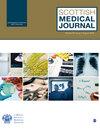Scottish Renal Association
IF 1.2
4区 医学
Q2 MEDICINE, GENERAL & INTERNAL
引用次数: 1
Abstract
Intro: Sodium/glucose cotransporter-2 inhibitors (SGLT2i) reduce risk of progressive kidney disease both in and out with the setting of diabetes. The aims of this study were to quantify the current uptake of canagliflozin within patients with type 2 diabetes in nephrology units within the west of Scotland and to identify barriers to prescribing. Methods: A retrospective analysis of the Scottish Electronic Renal Patient Record (SERPR) was performed to patients to secondary care nephrology services within NHS Greater Glasgow and Clyde (GGC) and NHS Lanarkshire who were eligible for SGLT2i. Canagliflozin is licensed for treatment of diabetic kidney disease (DKD) in patients with type 2 diabetes, estimated glomerular filtration rate (eGFR) >30 ml/min/1.73 m, urinary albumin:creatinine ratio (uACR) >30 mg/mmol. A questionnaire was produced to identify attitudes towards prescribing SGLT2i’s. The survey was composed of 5 questions on GoogleForms and Survey Monkey platforms. These were disseminated via email to prescribers in NHS GGC (nephrology only) and NHS Lanarkshire (nephrology and medical specialties). Results: From the retrospective SERPR analysis, there were 74 patients in NHS Lanarkshire identified as eligible, of whom 8 (11%) had been prescribed canagliflozin. In NHS GGC, 148 patients were identified as eligible of whom 57 (38.5%) had been prescribed canagliflozin. There were 58 survey responses gathered in NHS Lanarkshire and 18 responses from NHS GGC. Within NHS Lanarkshire 35.5% of respondents were consultants, 19.0% were registrars, and 34.5% were foundation or core trainee doctors. Respondents in NHS Lanarkshire felt that the main responsibility for prescribing SGLT2i lay with diabetes (55.1%), then all specialties equally (39.7%), GP (20.7%) and cardiology (17.2%). Only 24.1% of respondents in NHS Lanarkshire had started a patient on an SGLT2i and 29.3% felt they had access to adequate information to commence a patient on SGLT2i. Within NHS GGC, 72.2% of respondents were consultants and 11.1% were registrars, 83.3% had prescribed SGTL2i and 94.4% of respondents felt as though they had adequate information to commence patients of SGLT2i treatment. Within NHS GGC 61.1% of respondents felt every specialty had equal responsibility to start patients on SGLT2i, followed by diabetes (33.3%), nephrology (33.3%) and GP (27.8%). Conclusion: SGLT2i prescribing in patients with DKD remains low. A variety of factors contribute towards this, including inadequate provision of information to clinicians regarding commencing SGLT2i, concerns over serious side effects of SGLT2i (such as euglycemic DKA) and disagreement over whose responsibility it should be to commence these medications. Providing furthereducation and readily accessible prescribing resources to clinicians, and particularly to training grade doctors, may help to increase uptake of SGLT2i.苏格兰肾脏协会
简介:钠/葡萄糖协同转运蛋白2抑制剂(SGLT2i)可降低糖尿病患者发生进展性肾病的风险。本研究的目的是量化苏格兰西部肾脏科2型糖尿病患者目前对卡格列净的摄取情况,并确定处方障碍。方法:对符合SGLT2i条件的NHS Greater Glasgow and Clyde(GGC)和NHS Lanarkshire二级护理肾病服务的患者进行苏格兰电子肾脏患者记录(SERPR)的回顾性分析。卡格列净被许可用于治疗2型糖尿病患者的糖尿病肾病(DKD),估计肾小球滤过率(eGFR)>30 ml/min/1.73 m,尿白蛋白与肌酐比值(uACR)>30 mg/mmol。制作了一份问卷,以确定对开具SGLT2i的态度。该调查由GoogleForms和SurveyMonkey平台上的5个问题组成。这些信息通过电子邮件传播给NHS GGC(仅肾脏病学)和NHS拉纳克郡(肾脏病学和医学专业)的处方医生。结果:根据回顾性SERPR分析,拉纳克郡国家医疗服务体系有74名患者符合条件,其中8人(11%)服用了卡格列净。在NHS GGC中,148名患者被确定为符合条件,其中57人(38.5%)服用了卡格列净。拉纳克郡国家医疗服务体系(NHS Lanarkshire)收集了58份调查回复,GGC收集了18份回复。在拉纳克郡的NHS中,35.5%的受访者是顾问,19.0%是注册医生,34.5%是基金会或核心实习医生。拉纳克郡国家医疗服务体系的受访者认为,开具SGLT2i处方的主要责任在于糖尿病(55.1%),然后是所有专业(39.7%)、全科医生(20.7%)和心脏病学(17.2%。在NHS GGC中,72.2%的受访者是顾问,11.1%的受访者是登记员,83.3%的受访者开过SGTL2i处方,94.4%的受访者认为他们有足够的信息来开始SGLT2i治疗。在NHS GGC中,61.1%的受访者认为每个专业都有同等的责任让患者开始服用SGLT2i,其次是糖尿病(33.3%)、肾病学(33.3%和全科医生(27.8%)。结论:DKD患者的SGLT2i处方仍然很低。多种因素导致了这种情况,包括向临床医生提供的关于开始服用SGLT2i的信息不足,对SGLT2i的严重副作用(如血糖正常的DKA)的担忧,以及对谁应该负责开始服用这些药物的分歧。为临床医生,特别是培训级医生提供进一步的教育和易于获得的处方资源,可能有助于提高SGLT2i的使用率。
本文章由计算机程序翻译,如有差异,请以英文原文为准。
求助全文
约1分钟内获得全文
求助全文
来源期刊

Scottish Medical Journal
医学-医学:内科
CiteScore
4.80
自引率
3.70%
发文量
42
审稿时长
>12 weeks
期刊介绍:
A unique international information source for the latest news and issues concerning the Scottish medical community. Contributions are drawn from Scotland and its medical institutions, through an array of international authors. In addition to original papers, Scottish Medical Journal publishes commissioned educational review articles, case reports, historical articles, and sponsoring society abstracts.This journal is a member of the Committee on Publications Ethics (COPE).
 求助内容:
求助内容: 应助结果提醒方式:
应助结果提醒方式:


